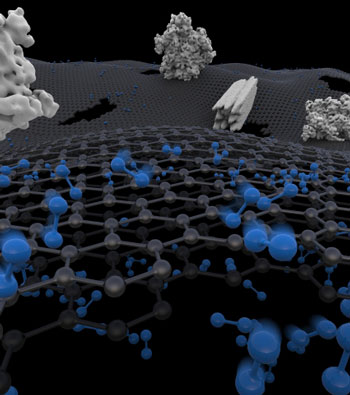 A new nanomembrane made out of graphene is extremely light and breathable. Not only can this open the door to a new generation of functional waterproof clothing, but also to ultra-rapid filtration. The membrane is as thin as is technologically feasible.
A new nanomembrane made out of graphene is extremely light and breathable. Not only can this open the door to a new generation of functional waterproof clothing, but also to ultra-rapid filtration. The membrane is as thin as is technologically feasible.
Apr 23rd, 2014
Read more
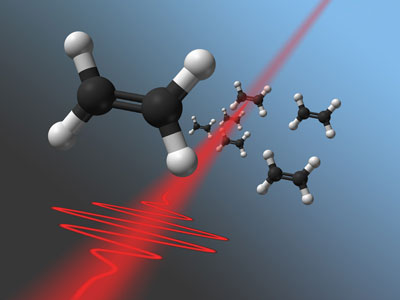 With ultra-short laser pulses, chemical reactions can be controlled; electrons have little mass and are therefore influenced by the laser, whereas the atomic nuclei are much heavier and are hardly affected.
With ultra-short laser pulses, chemical reactions can be controlled; electrons have little mass and are therefore influenced by the laser, whereas the atomic nuclei are much heavier and are hardly affected.
Apr 23rd, 2014
Read more
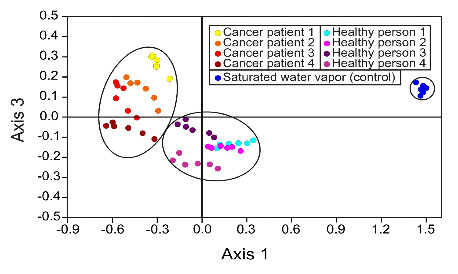 An array of functionalized membrane-type surface stress sensors distinguishes cancer patients from healthy people through a signature response to breath samples.
An array of functionalized membrane-type surface stress sensors distinguishes cancer patients from healthy people through a signature response to breath samples.
Apr 23rd, 2014
Read more
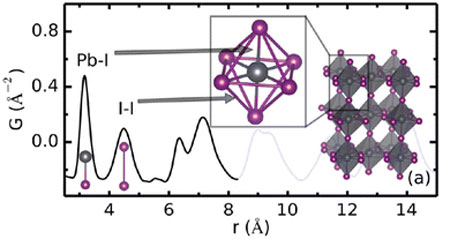 In the past few years, perovskite solar cells have made large leaps forward in efficiency, recently achieving energy conversion with up to 16 percent efficiency. These simple and promising devices are easy enough to make and are made up of earth abundant materials, but little work has been done to explore their atomic makeup.
In the past few years, perovskite solar cells have made large leaps forward in efficiency, recently achieving energy conversion with up to 16 percent efficiency. These simple and promising devices are easy enough to make and are made up of earth abundant materials, but little work has been done to explore their atomic makeup.
Apr 23rd, 2014
Read more
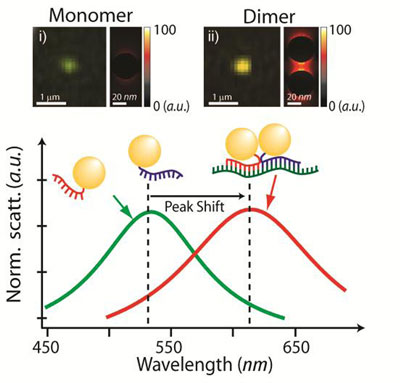 Purdue University researchers have developed a way to detect and measure cancer levels in a living cell by using gold nanoparticles with tails of synthetic DNA.
Purdue University researchers have developed a way to detect and measure cancer levels in a living cell by using gold nanoparticles with tails of synthetic DNA.
Apr 23rd, 2014
Read more
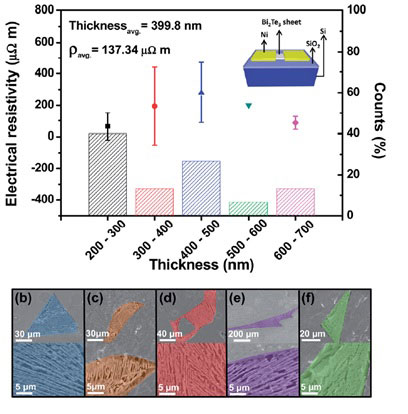 Two groups of researchers have recently advanced the field of solar cells with a cheaper and efficient replacement for platinum and better synthesis of zinc oxide.
Two groups of researchers have recently advanced the field of solar cells with a cheaper and efficient replacement for platinum and better synthesis of zinc oxide.
Apr 23rd, 2014
Read more
PETA International Science Consortium will present a non-animal tiered-testing strategy for nanomaterial hazard assessment at the 7th International Nanotoxicology Congress being held in Antalya, Turkey on Apr. 23-26, 2014. The proposed strategy will generate meaningful information on nanomaterial properties and their interaction with biological systems.
Apr 22nd, 2014
Read more
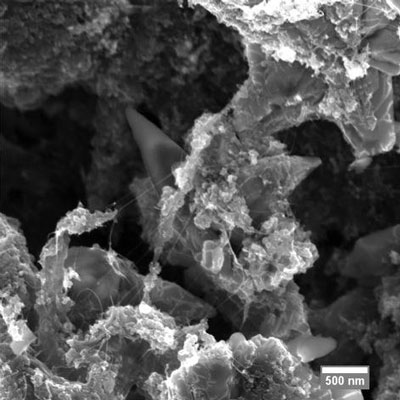 Future devices based on technology could bridge gap between batteries and conventional capacitors in portable electronics and hybrid electric vehicles.
Future devices based on technology could bridge gap between batteries and conventional capacitors in portable electronics and hybrid electric vehicles.
Apr 22nd, 2014
Read more
Quantum simulators recreate the behaviour on a microscopic scale of biological and quantum systems and even of particles moving at the speed of light. The exact knowledge of these systems will lead to applications ranging from more efficient photovoltaic cells to more specific drugs. Researchers are working on the design of several of these quantum simulators so they can study the dynamics of complex physical systems.
Apr 22nd, 2014
Read more
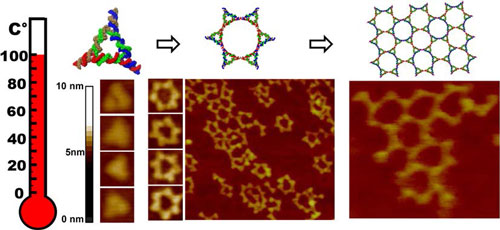 A team of nanotechnology researchers at the University of Kentucky has discovered new methods to build heat resistant nanostructures and arrays using RNA.
A team of nanotechnology researchers at the University of Kentucky has discovered new methods to build heat resistant nanostructures and arrays using RNA.
Apr 22nd, 2014
Read more
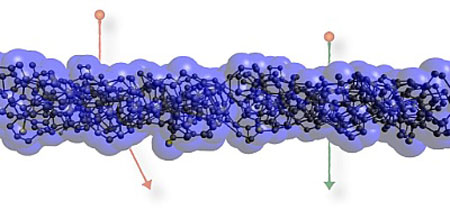 Ions are an essential tool in chip manufacturing, but these electrically charged atoms can also be used to produce nano-sieves with homogeneously distributed pores. A particularly large number of electrons, however, must be removed from the atoms for this purpose. Such highly charged ions either lose a surprisingly large amount of energy or almost no energy at all as they pass through a membrane that measures merely one nanometer in thickness. This discovery is an important step towards developing novel types of electronic components made of graphene.
Ions are an essential tool in chip manufacturing, but these electrically charged atoms can also be used to produce nano-sieves with homogeneously distributed pores. A particularly large number of electrons, however, must be removed from the atoms for this purpose. Such highly charged ions either lose a surprisingly large amount of energy or almost no energy at all as they pass through a membrane that measures merely one nanometer in thickness. This discovery is an important step towards developing novel types of electronic components made of graphene.
Apr 22nd, 2014
Read more
In the quest to make sun power more competitive, researchers are designing ultrathin solar cells that cut material costs. At the same time they're keeping these thin cells efficient by sculpting their surfaces with photovoltaic nanostructures that behave like a molecular hall of mirrors.
Apr 22nd, 2014
Read more
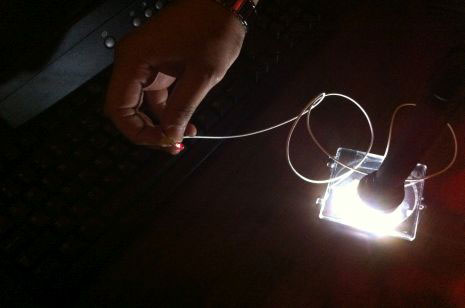 Engineering researchers have achieved the highest efficiency ever in a 9 millimeter-squared solar cell made of gallium arsenide. After coating the cufflink-sized cells with a thin layer of zinc oxide, the research team reached a conversion efficiency of 14 percent.
Engineering researchers have achieved the highest efficiency ever in a 9 millimeter-squared solar cell made of gallium arsenide. After coating the cufflink-sized cells with a thin layer of zinc oxide, the research team reached a conversion efficiency of 14 percent.
Apr 22nd, 2014
Read more
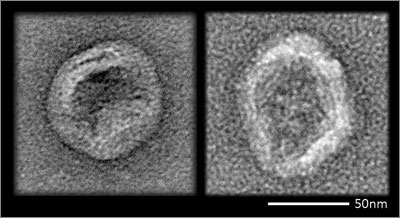 It's a familiar trope in science fiction: In enemy territory, activate your cloaking device. And real-world viruses use similar tactics to make themselves invisible to the immune system. Now scientists have mimicked these viral tactics to build the first DNA nanodevices that survive the body's immune defenses.
It's a familiar trope in science fiction: In enemy territory, activate your cloaking device. And real-world viruses use similar tactics to make themselves invisible to the immune system. Now scientists have mimicked these viral tactics to build the first DNA nanodevices that survive the body's immune defenses.
Apr 22nd, 2014
Read more
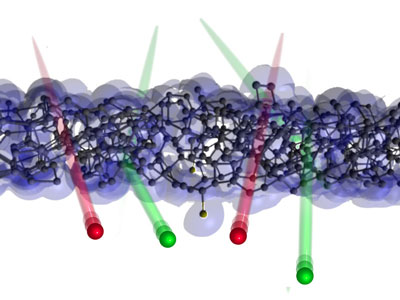 A bullet fired through a block of wood will slow down. In a similar way, ions are decelerated when they pass through a solid material: the thicker the material, the larger the energy loss will be. However, this picture breaks down in ultra-thin target materials, which only consist of a few layers of atoms.
A bullet fired through a block of wood will slow down. In a similar way, ions are decelerated when they pass through a solid material: the thicker the material, the larger the energy loss will be. However, this picture breaks down in ultra-thin target materials, which only consist of a few layers of atoms.
Apr 22nd, 2014
Read more
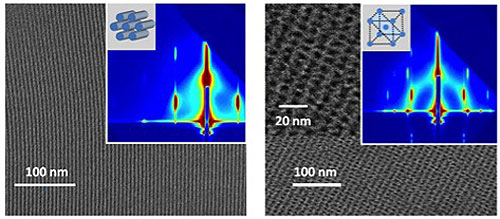 Researchers have synthesized a new class of macromolecules that self-assemble into various ordered structures with feature sizes smaller than 10 nanometers. Called 'giant surfactants', these large molecules mimic the structural features of small surfactants but have been transformed into functional molecular nanoparticles by being 'clicked' with polymer chains. The resulting materials are unique because they bridge the gap between small molecule surfactants and traditional block copolymers and thus possess an interesting duality in their self-assembly behaviors.
Researchers have synthesized a new class of macromolecules that self-assemble into various ordered structures with feature sizes smaller than 10 nanometers. Called 'giant surfactants', these large molecules mimic the structural features of small surfactants but have been transformed into functional molecular nanoparticles by being 'clicked' with polymer chains. The resulting materials are unique because they bridge the gap between small molecule surfactants and traditional block copolymers and thus possess an interesting duality in their self-assembly behaviors.
Apr 22nd, 2014
Read more
 A new nanomembrane made out of graphene is extremely light and breathable. Not only can this open the door to a new generation of functional waterproof clothing, but also to ultra-rapid filtration. The membrane is as thin as is technologically feasible.
A new nanomembrane made out of graphene is extremely light and breathable. Not only can this open the door to a new generation of functional waterproof clothing, but also to ultra-rapid filtration. The membrane is as thin as is technologically feasible.












 Subscribe to our Nanotechnology News feed
Subscribe to our Nanotechnology News feed